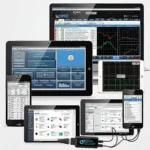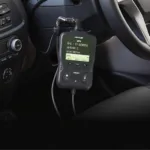Understanding Subaru OBD2 fault codes is crucial for maintaining your vehicle’s performance and longevity. Whether you’re a seasoned mechanic or a Subaru owner keen on DIY repairs, this guide will equip you with the knowledge to interpret those cryptic codes and address potential issues. We’ll cover everything from common Subaru codes to advanced diagnostics, empowering you to take control of your car’s health. cable obd2 mini usb offers various connection options for your scanning needs.
Common Subaru OBD2 Fault Codes and Their Meanings
Subaru, like all car manufacturers, utilizes standardized OBD2 codes. However, certain codes appear more frequently in Subarus. Let’s explore some of the most common ones:
- P0420 (Catalyst System Efficiency Below Threshold): This often indicates a failing catalytic converter, a critical component of your Subaru’s emissions system.
- P0301 (Cylinder 1 Misfire Detected): A misfire can stem from various issues, including faulty spark plugs, ignition coils, or fuel injectors.
- P0171 (System Too Lean (Bank 1)): This suggests insufficient fuel delivery or excess air intake, potentially pointing to problems with the fuel pump, oxygen sensor, or air filter.
- P0135 (O2 Sensor Heater Circuit Malfunction (Bank 1, Sensor 1)): This code highlights an issue with the oxygen sensor’s heating element, crucial for accurate readings.
- P0031 (HO2S Heater Control Circuit Low (Bank 1, Sensor 1)): Similar to P0135, this indicates a problem with the oxygen sensor heater circuit.
Diagnosing Subaru OBD2 Fault Codes: A Step-by-Step Approach
Diagnosing OBD2 codes requires a systematic approach to pinpoint the root cause:
- Retrieve the Code: Use an obd2 oil pressure gauge compatible OBD2 scanner to read the fault codes stored in your Subaru’s ECU.
- Research the Code: Understand the specific meaning of the retrieved code using reliable resources like this guide or manufacturer databases.
- Inspect Related Components: Based on the code’s description, visually inspect the related components for any obvious damage or irregularities.
- Perform Tests: Conduct specific tests as recommended by the code’s diagnostic procedure. This might involve checking voltage, resistance, or performing component-specific tests.
- Address the Issue: Once the problem is identified, repair or replace the faulty component. If you are facing issues like obd2 scan tool erase fail, ensure your scanner and connection are functioning properly.
- Clear the Code: After the repair, clear the fault code using your OBD2 scanner and verify that it doesn’t reappear.
Advanced Diagnostics for Subaru OBD2 Fault Codes
For more complex issues, advanced diagnostic techniques may be necessary. These include:
- Live Data Streaming: Observing real-time sensor data can provide valuable insights into the vehicle’s operation and pinpoint intermittent issues.
- Freeze Frame Data: This snapshot of sensor readings at the time of the fault can help identify the conditions that triggered the code.
- Bi-directional Controls: Certain advanced scanners allow you to activate specific components, like fuel injectors or solenoids, to test their functionality.
What do Subaru OBD2 fault codes mean?
Subaru OBD2 fault codes represent specific malfunctions detected by the vehicle’s onboard diagnostic system. They provide valuable clues for troubleshooting and repairing issues.
Where can I find information about specific Subaru OBD2 codes?
Reliable resources for Subaru code information include online databases, repair manuals, and forums. OBDFree also provides detailed information on specific codes, such as obd2 code p0301.
“Understanding the context of the fault code within the specific Subaru model is essential for accurate diagnosis,” says John Miller, a seasoned automotive diagnostician with over 20 years of experience. “Don’t rely solely on generic code definitions. Consult Subaru-specific resources for a more precise understanding.”
Conclusion
Mastering Subaru OBD2 fault codes is a valuable skill for any Subaru owner. This guide provides a foundation for understanding, diagnosing, and addressing these codes, empowering you to maintain your Subaru’s optimal performance and longevity. Remember to always consult reliable resources and seek professional help when needed. Understanding 2000-2004 subaru outback obd2 specifics can be especially helpful. Properly addressing subaru obd2 fault codes is crucial for ensuring a smooth and safe driving experience.
FAQ:
- What does the OBD2 port do in a Subaru?
- How do I read Subaru OBD2 fault codes?
- Can I clear Subaru OBD2 codes myself?
- What are the most common Subaru OBD2 codes?
- Where can I find more information about specific Subaru OBD2 codes?
- What should I do if a code reappears after clearing it?
- Are there any risks associated with using an OBD2 scanner on my Subaru?
For support contact us via WhatsApp: +1(641)206-8880, Email: [email protected] or visit us at 789 Elm Street, San Francisco, CA 94102, USA. We offer 24/7 customer support.

